The Philippines is home to more than 7000 islands, so it is only natural that the country is highly regarded for its pristine islands and beaches. However, Philippine waterfalls are another type of natural attraction that the country is proud of.
Waterfalls in the Philippines are incredible natural creations. They are both strikingly beautiful and powerful. Getting to them is an adventure in itself as they are tucked in jungles and mountains.
There are hundreds of waterfalls spread across the country. Every region possesses at least one. In places like Cebu in the Visayas and Lake Sebu in Mindanao, you will find at least 2 to 3 waterfalls in one area. Laguna, just a few hours away from capital Manila, houses some gorgeous waterfalls. Meanwhile, Iligan City in Mindanao is called the “City of Majestic Waterfalls'' as it is home to about 20 waterfalls.
Although the Philippines have an overwhelming number of waterfalls, there are ones that stand out because of their beauty and unique qualities.
Here are the top Philippines waterfalls you should consider visiting:
15. Pulang Bato Falls (Valencia, Negros Oriental)

Pulang Bato Falls sits in the Ocoy Valey in the Valencia town Negros Oriental. It is often referred to as the Red River because of the surrounding red color rocks you will see around the falls. Pula is the Filipino word for “red”.
At the foot of the waterfalls lies swimming lagoons filled with fresh water coming from the falls. Expect Pulang Bato’s water to be cool because it comes from the mountains that enjoy a moderate to cool temperature.
- Check out our 2-week Philippine itinerary packages
The swimming area at the foot of the waterfalls is deep. Brave visitors would usually climb the nearby rocks and dive straight toward the water basin.
Pulangbato Falls is surrounded by thick vegetation and trees. It is considered unique because of its layered structure. At the first tier, the cascade begins narrowly. It eventually widens as it moves down to the succeeding levels. At a distance, this waterfall looks triangular. Guests can rent rustic huts. There are also small stores near the falls area that sell light snacks.
The access point for Pulangbato is the town of Valencia. The waterfall is only a 20-minute ride from Dumaguete City. Trips to the Pulang Bato are usually included in Dumaguete tours, but you can also hire a rental service to bring you to the site.
14. Casaroro Falls (Valencia, Negros Oriental)
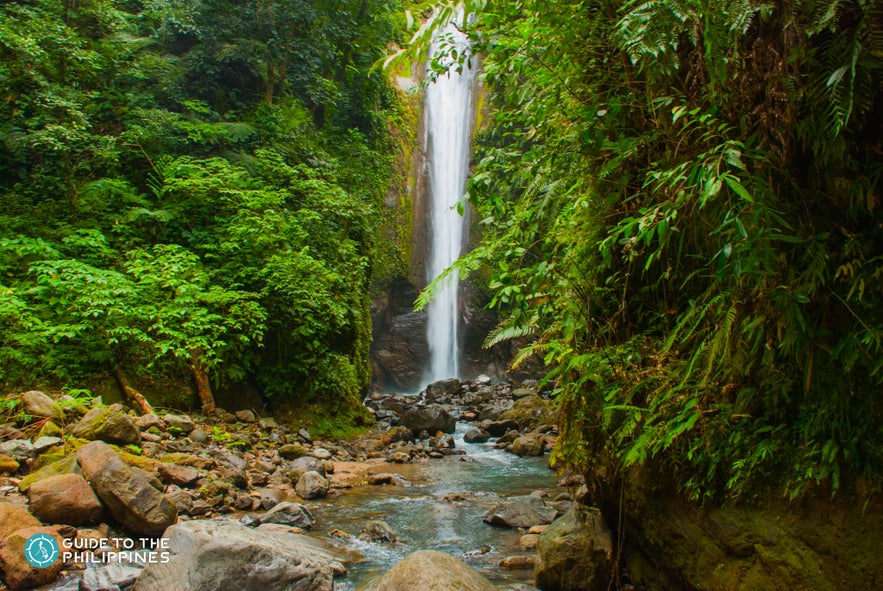
Casaroro Falls is another prominent waterfall that is also located in the town of Valencia, Negros Occidental. It is considered to be the most popular cascades in the region and is widely photographed. Casaroro has become an iconic Negros province landmark.
This waterfall is tucked within the hilly landscape of Valencia. It stands at the foot of Mount Talinis. To access the site, you will need to do some trekking. Concrete paths and a 350-step staircase lead to Casaroro.
Casaroro is a narrow single-layer waterfall. But it’s powerful and high, standing at 100 feet above the water. There is usually a large volume of water flowing from this waterfall. This sheer volume is responsible for the roaring sound this waterfall makes.
The water basin beneath the falls is deep and cold. From the basin, the waterfalls further down into a stream. Huge rocks sit around the basin. Travelers who join a Casaroro Falls tour usually use these rocks as a place to rest and just enjoy the view of the tall waterfall.
Casaroro is about 9.4 kilometers west of Dumaguete City. From Dumaguete, you can go to Valencia town first. From there, you can take a motorcycle driver to take you to the trailhead.
13. Mag-Aso Falls (Kabankalan, Negros Occidental)
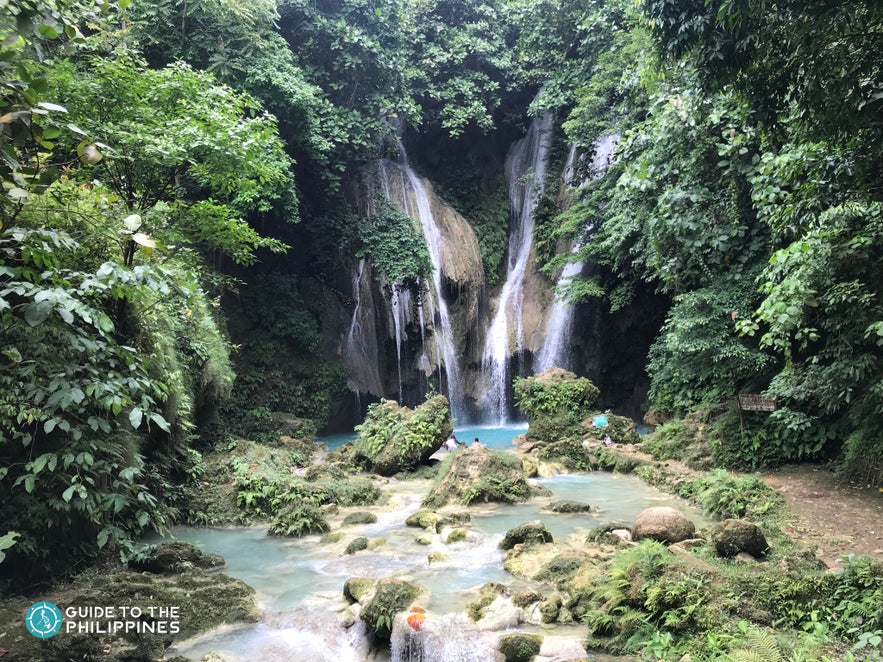
Negros Occidental will not disappoint you when it comes to waterfalls. One of the region’s pride is Mag-Aso Falls. This attraction is located in Oringao, Kabankalan City, south of the capital Bacolod City in Negros Occidental. Mag-Aso is less known to domestic tourists coming from Manila. However, its beauty deserves attention. This waterfall features clear blue water and generates a mist that mesmerizes people. The local word “aso” means mist.
Mag-Aso stands at 120 feet (37 meters) high and drops into this deep swimming basin. To access the falls, you will need to climb down a set of stairs with about 108 steps.
There’s a small entrance fee to Mag-Aso, as there is a resort beside it. This resort is owned and operated by the small government. The resort has rooms for visitors who want to stay overnight. If you’re visiting on a day trip, you can still rent one of the cottages in the area.
Aside from the waterfalls, you can also swim in the manmade pool. The pool water comes from the falls, and it is shallow enough for children to swim in it.
12. Asik-Asik Falls (North Cotabato)

Tucked in the Alamada Region of North Cotabato, Asik Asik Falls is one of the most unique falls you will ever find in the Philippines. No one knows how this incredible natural attraction came about. Asik-Asik was either not always there or was not noticed by locals. It was discovered around 2010 and became quickly popular. Thick and lush vegetation decorates the rock face and adds to the dramatic look of Asik-Asik.
Asik-Asik is a towering 20-meter high rock mountain with several holes that emit cold water seemingly coming from within the rock. The streams of water coming out from the mountain cover its entire 140-meter width and look more like a natural water curtain instead of the usual cascades.
The water goes down directly to a river instead of a water basin. The water level of the river is shallow enough for small kids to bathe in it. To reach Asik-Asik, you need to descend the 1500 steps wrapped around the rock mountain.
To reach Asik-Asik is an adventure in itself as it is situated in a remote region of North Cotabato. The fall is specifically located near Sitio Dulao, Dado village, Alamada. Davao City or Cotabato City are the two nearest main cities to the falls.
11. Merloquet Falls (Zamboanga City)

Merloquet Falls proves to be one of the most breathtaking waterfalls in the Philippines. It is not too high or too powerful, but it is gorgeous with a very relaxing ambiance.
The waterfall is made up of two tiers, with the second one being the most prominent. The first tier is shorter at 5 meters and is made up of rock formation layers. The best thing about going up the first tier is you get an interesting bird-eye view of the second tier.
Merloquet’s second tier is the main attraction standing at about 10 meters. From the top, the water flows into a 15- meter wide wall that looks like a set of stairs. The water flow is consistent enough that it creates this liquid white curtain appearance. Lush vegetation surrounds the falls, and a shallow natural pool is located underneath.
Merloquet Falls is located in Barangay Sibulao, about 78 kilometers from Zamboanga City. Visitors tend to book a van or drive their car to reach the falls. From the entrance point, you need to hike downhill for about 500 meters (300 steps) to reach Merloquet.
Because of its remoteness, the area surrounding Merloquet Falls maintains its natural look. Drinking, eating, and leaving trash at the falls area are not permitted.
10. Tinago Falls (Iligan)
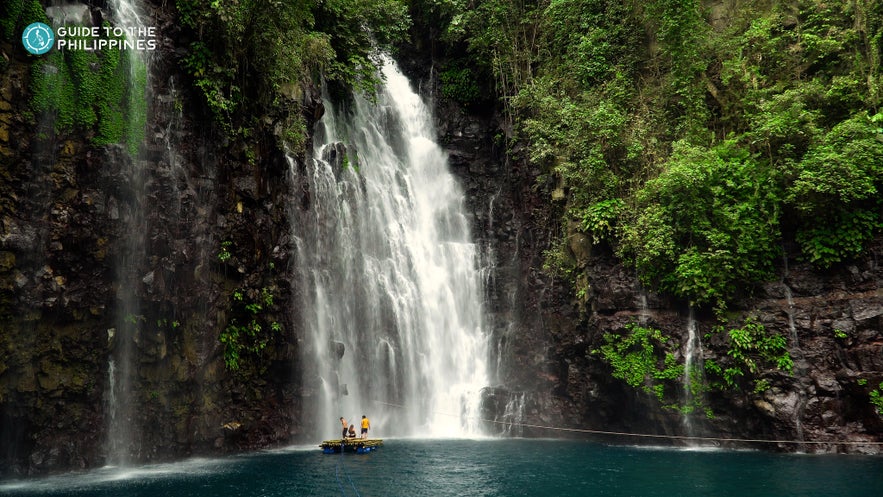
Tinago Falls is one of Lanao del Norte’s natural wonders and main tourist attractions. The name “Tinago” means “hidden” in Tagalog. For many years, Tinago was kept hidden and virtually unknown to tourists.
At 240 feet high, Tinago commands instant admiration to anyone who visits it. Huge rock formations, tall trees, and thick vegetation serve as its background. The water that comes from Lanao Lake does not only flow through one area of the waterfall. There is also water that flows from the many holes scattered around the large rock wall. This feature gives Tinago its dramatic appearance.
Its water basin is another striking feature of this waterfall. This deep basin is filled with blue-green colored water that’s simply breathtaking to watch.
Tinago Falls is located in Iligan City. The nearest airport to the attraction is the Laguindingan International Airport in Cagayan de Oro. From Cagayan de Oro, you need to drive about one and a half (64 kilometers) to get to Iligan City. Once you reach the entrance of Tinago falls, you need to descend around 500 steps to get to the base.
9. Pagsanjan Falls (Laguna)

Pagsanjan Falls is one of the most popular Laguna tourist spots, and one of the most recognizable waterfalls in the country. It was originally called Magdapio Falls.
Pagsanjan Falls is high and powerful, standing at around 300 feet (9.44 meters). It has three tiers and a very deep water basin. Like other waterfalls in the list, Pagsanjan is surrounded by rock boulders and lush vegetation, with mountains in the distance.
There are two ways to reach the base of the waterfall. The first way starts from Cavinti Town. This route is more challenging as it requires some hiking and rappelling. The second way is the more popular choice among tourists. This way involves a banca (local canoe) ride with the boatman guiding you around the base of the waterfalls.
If you are feeling adventurous, book the “Shooting the Rapids” tour. This raft experience involves descending downstream at a fast speed and going into a cave right past the base of the waterfalls.
The actual Pagsanjan Falls is located in the town of Cavinti. But if you would like to take a boat ride, then you need to head to Pagsanjan town. There is a tourism office in the town that offers information about boat tours. You can also pre-book a Pagsanjan Falls tour for a hassle-free trip.
8. Maria Cristina Falls (Iligan City)
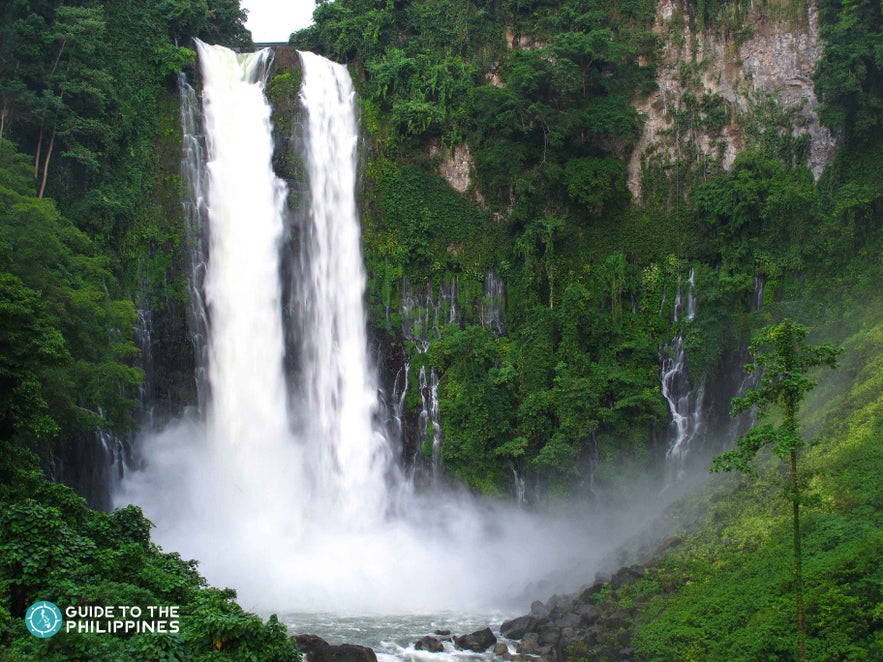
Maria Cristina Falls is one of the most powerful waterfalls in the country. At the height of 320 feet (97 meters), this fall’s strong current can generate about 200 megawatts of electricity. Maria Cristina is important to Mindanao as it provides 70% of the island’s electricity.
Maria Cristina is often called the “twin falls” because a rock below the falls divides the flow of water, making it appear that there are two sets of cascades.
Due to its strong current, swimming is not allowed in the area. The waterfall is still available for viewing but only during Saturday, Sundays, and special holidays when the hydroelectric power plant is closed. If the power plant operates, there is less water flow in the review.
The 3rd floor of the powerplant (National Power Corporation) has a viewing deck and glass room where you can admire the waterfall. The National Power Corporation also developed a nature park in the waterfall area. Here, tourists can enjoy outdoor activities like trekking and rock climbing and visit a souvenir shop.
You will find Maria Cristina Falls in the suburbs of Iligan City, bordered by Barangay Buru-un, Ditucalan, and Maria Cristina.
7. Tinuy-an Falls (Surigao del Sur)
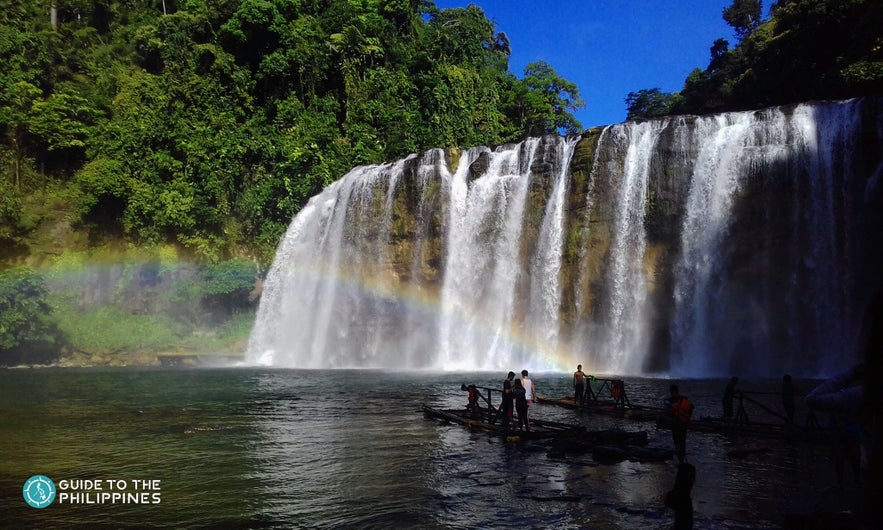
Locals proudly call Tinuy-an Falls the "Crown Jewel of Surigao del Sur." The province is proud of this attraction for its natural captivating beauty. Tinuy-an is about 180 feet (55 meters) tall and 311 feet wide (95 meters).
Tinuy-an’s width is its most impressive asset and is what makes it unique among other waterfalls in the country. It's considered one of the widest waterfalls in the Philippines. People call it the little Niagara Falls of the Philippines because of its similarity to the famous waterfall of Canada.
Tinuy-an Falls has three tiers located in a thick jungle setting. The tiers have their own natural pools, where you can relax and take a dip. To reach the upper tier, you will need to climb up a paved stairway on the side.
On the second tier, visitors tend to ride on bamboo rafts to reach the wall of the waterfall where water flows. Tinuy-an is also known for its rainbow that shows up between 9 to 11 am every day.
Tinuy-an has a small playground, some cottages, and picnic tables. You will find this waterfall in Barangay Burboanan, about 18 kilometers from Bislig’s town center.
6. Limunsudan Falls (Bukidnon and Iligan City)
Limunsudan Falls is not as widely known as the ones included in the list. Nonetheless, this waterfall deserves mention due to its beauty and magnificence. At 870 feet (265 meters) high, Limunsudan Falls is one of the highest waterfalls in the Philippines.
Limunsudan Falls is set within the boundaries of Lanao del Sur, Lanao del Norte, and Bukidnon. Its jumping point is the town of Talakag, Bukidnon. From the town center, you will need to travel to the falls using a car or a local motorcycle transport called habal-habal. The site has a viewing deck that also serves as an entrance to Limunsudan.
- Book a Dahilayan Forest Park package with a Del Monte pineapple plantation tour
- Enjoy a Bukidnon flower farm & cafe tour
- See other Bukidnon tours
The viewing deck gives you a panorama of the entire waterfalls. From the viewing deck, you can choose to trek further down to the waterfall's bottom stream. This trek lasts for about an hour. The local Higaonon people believe that spirits live around Limunsudan. Thus, guides usually pray to the spirits before letting visitors trek down the waterfalls.
Take note that the trail down is narrow, steep, and often muddy. You are not allowed to swim as the currents are strong and dangerous.
5. Kaparkan Falls (Abra)
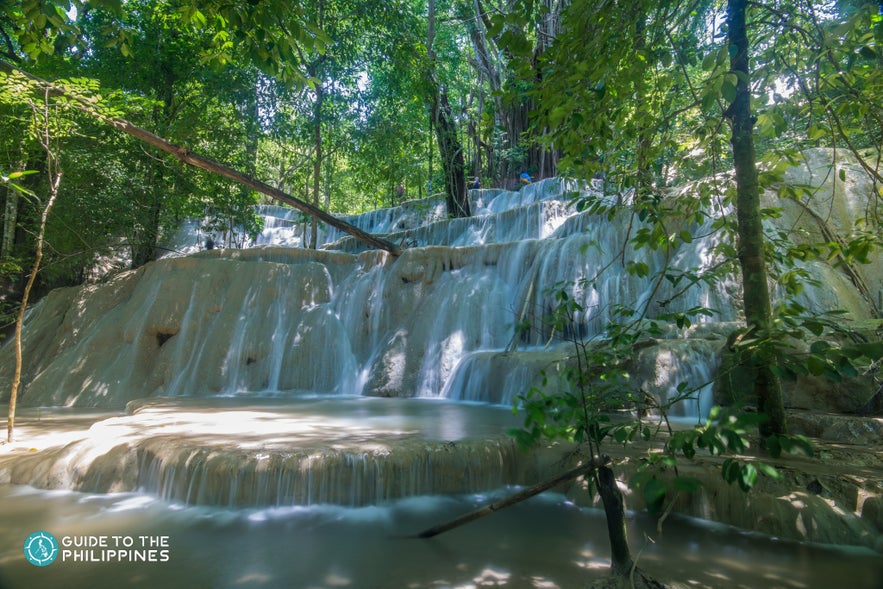
If you’re looking for stunning waterfalls in Luzon, then Kaparkan Falls is worth a look! Kaparkan Falls (also called Mulawin Falls) is located in Tineg Municipality of Benguet, Abra. This waterfall features water flowing to several layers of limestone terraces. These terraces appear like water basins filled with clean and refreshing water.
Kaparkan Waterfall flows through the many small terraces until the Tineg River. It is truly a marvelous sight!
The best time to visit Kaparkan is during the rainy months of July and September. Somehow, frequent rain turns the color in Kaparkan’s natural pool water into emerald green.
You need to register with the local government at the town center before heading to the waterfalls. The registration also comes with an orientation from officials. They tell you what to expect when hiking to the waterfalls.
Kaparkan Falls is one of the hardest waterfalls to get to. The road is unpaved and underdeveloped. You will need to ride a monster truck for most of the way. Then, you will need to get off and hike for 15 to 20 minutes to reach the waterfall.
4. Seven Falls (South Cotabato)
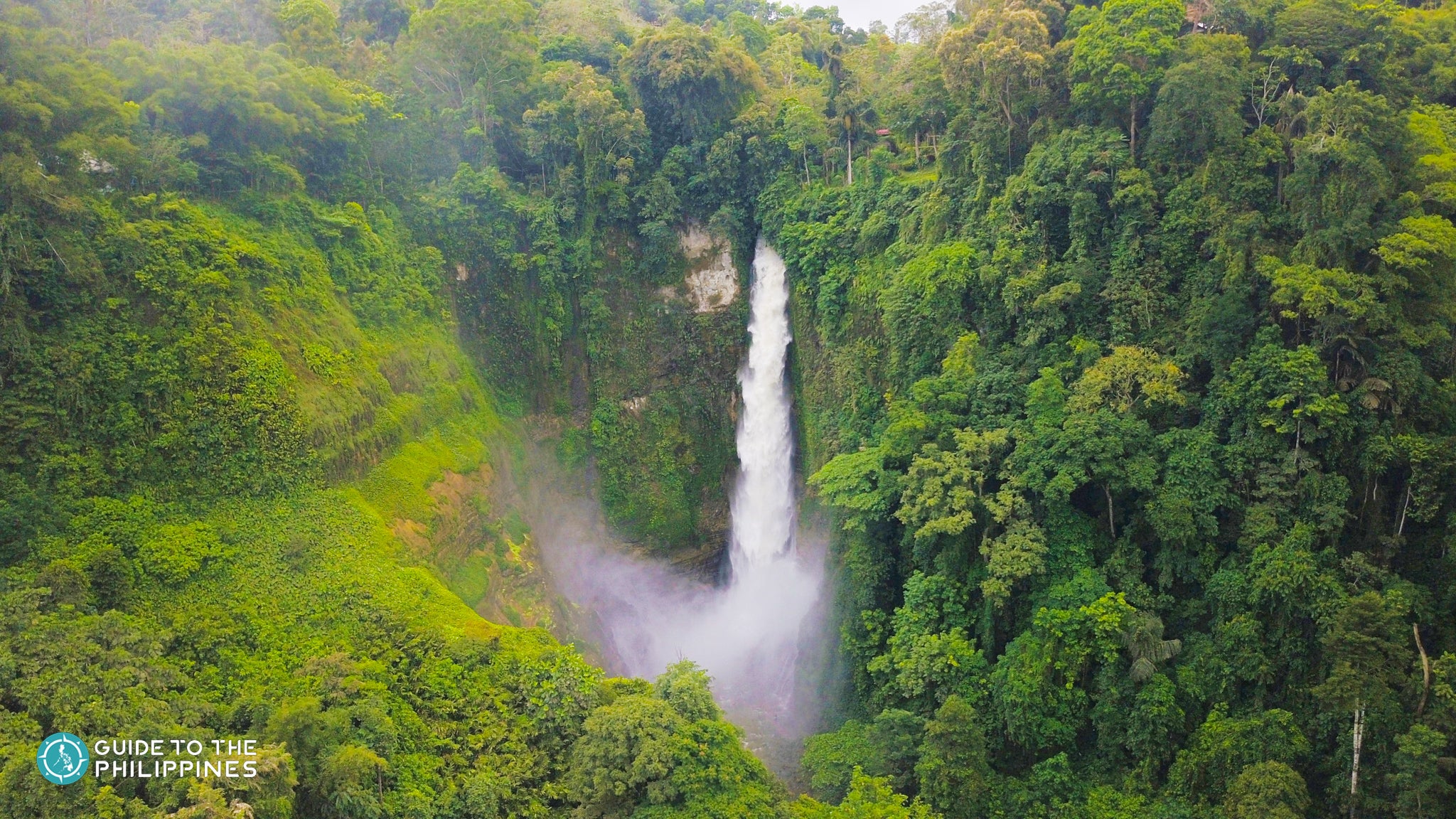
Seven Falls is a collection of waterfalls located in the highlands of South Cotabato. The existence of seven waterfalls in one area is what makes Seven Falls a unique water attraction. All seven waterfalls receive water from Lake Sebu, the region’s most prominent watershed.
The first two waterfalls are the most accessible among the seven. The first waterfall is called Hikong Alo (35 feet tall) and the second one is Hikong Bente (70 feet tall). The other five are Hikong B’Lebel, Hikong Lowig, Hikong Ukol, Hikong K’Fo-I, and Hikong Tonok. These five get fewer visitors because you need to hike a great deal to access them.
The most popular way to see all seven waterfalls is by riding the Seven Falls Zipline, which starts from the first waterfall. This zipline is one of the tallest in Asia. It is about 180 meters above the ground and about 300 meters above sea level. The zipline has two lines - the first one is 740 meters long while the second is 42 meters long.
General Santos City is the closest major city to Lake Sebu town and Seven Falls. The city’s Bulaong Terminal has vans that regularly go to Lake Sebu. When you reach Lake Sebu, you can hire a motorcycle to take you to the first two waterfalls in Barangay Seloton.
3. Aliwagwag Falls (Davao Oriental)
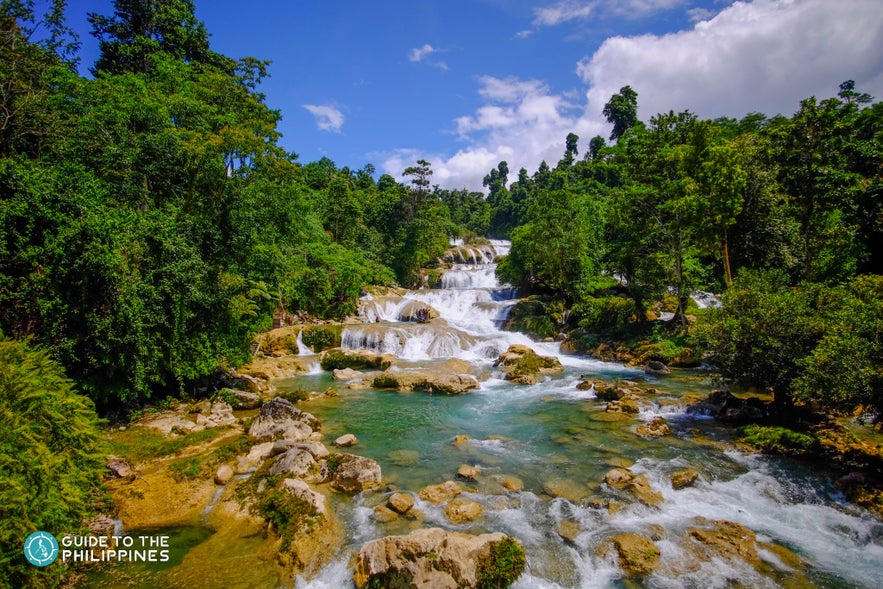
Aliwagwag Falls is a premier tourist site in Davao Oriental. It has become popular because of its sheer height, which is 1,100 feet (335 meters). Aliwagwag is considered one of the highest waterfalls in the country.
Aside from its height, Aliwagwag impresses people with its structure. The falls have a total of 84 tiers surrounded by boulders that look like an elaborate staircase.
According to local folklore, Aliwagwag is a gift to the local Mandaya Tribe from the gods themselves.
Aliwagwag is maintained and protected by the local government. It is one of the 94 National Integrated Protected Areas. The surroundings of Aliwagwag are also transformed into an eco-park.
While at the eco-park, you can zipline across the Cateel River, follow hiking trails, or cross the 45-meter long Monkey Bridge. Monkey Bridge is a bridge made of three ropes that go across the width of the waterfall.
Davao City is the nearest major city to Aliwagwag. The Cateel Town is the jumping point for Aliwagwag Falls.
2. Cambugahay Falls (Siquijor)
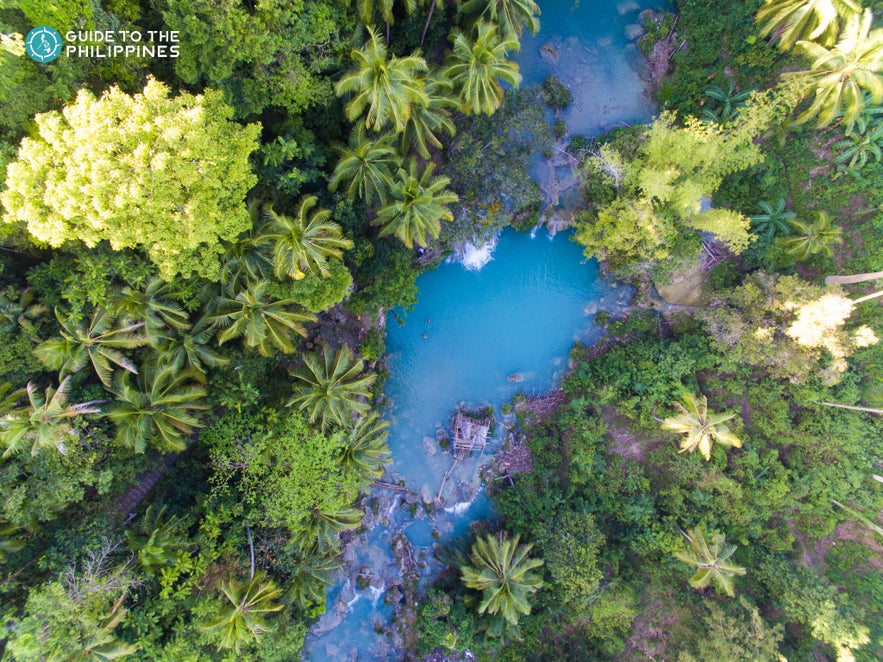
Cambugahay Falls in Siquijor Island is considered to be one of the most majestic waterfalls in the entire country and is a must-visit during Siquijor tours. Such prominence is mostly due to Cambugahay's clear turquoise water, which is a rare feature. The water at Cambugahay is remarkably clean and warm as it comes from the natural springs from the mountainside.
The spring water flows down to three tiers covering a total distance of around three kilometers. Each level has natural lagoons that you can swim in.
Cambugahay’s bottom part is the most visited and easily accessible. However, you will need to climb down 135 steps to reach it. This bottom tier has a large and deep natural pool perfect for swimming. If you want to visit the second and third tiers, you need to trek through the jungle.
You can rent a bamboo raft to get closer to the base of the waterfall. There are local shops around the waterfall area where you can buy snacks and rent swimming gear.
Cambugahay Falls is situated in the town of Lazi. Once you are in Siquijor, getting to Cambugahay Falls is easy. You can rent a motorcycle, tricycle (three-wheeled transport) or a car to get to the town of Lazi.
1. Kawasan Falls

Kawasan Falls in Cebu takes the top spot on this list because everything about this attraction is picturesque. This waterfall has two tiers surrounded by limestone canyon walls with a lush jungle at the back.
- Read our Kawasan Falls travel guide to learn more
The first tier is the main waterfall and features a height of about 40 meters. At the bottom of this tier lies a deep swimming hole. The second tier is about 20 meters high and is often less crowded. You will need to trek for 10 minutes to reach the second tier from the first.
Kawasan is also famous because of its clear turquoise water at the base of the waterfall tiers. This color is incredible to look at and the reason why locals call Kawasan the “Gatorade Factory.”
One of the best ways to experience Kawasan Falls is to join canyoneering tours. This trip is highly recommended and is a favorite among repeat visitors to Kawasan. Kawasan Falls tours highlight hiking through the jungle and canyons and cliff jumping from a height of more than 12 meters.
If the canyoneering tour seems too physically demanding, you may just visit Kawasan Falls independently.
Kawasan Falls is located on the island of Cebu, in Barangay Matutinao, Badian. From Cebu City, you will need to drive 3.5 hours (104 kilometers away) to reach Badian. There are picnic tables, cottages, and rooms onsite that are available for rent. You can also hire a bamboo raft and guide to take you to where the water drops.
Explore the Best Waterfalls in the Philippines
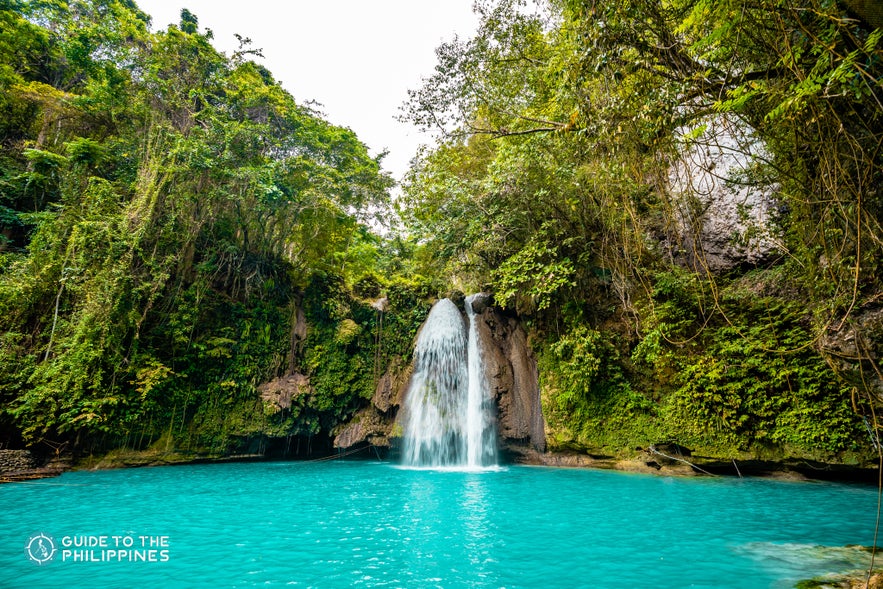
Falls in the Philippines are generally affordable tourist destinations. Although you need to pay entrance fees to access most of them, such fees do not exceed 2 USD. During your visit, be sure to bring your snacks and drinks. Bringing extra clothes and wearing proper footwear like hiking shoes are also important.
You can find some waterfall restaurants in the Philippines, but the remote waterfalls usually don’t have convenient tourist infrastructures.
Local government units typically maintain the Philippine waterfalls, and most of them are available to the public. It is the responsibility of every visitor to keep the waterfall surroundings clean. Before leaving, make sure to clean after yourself and bring any trash with you.
Expect that the best Philippine waterfalls are located in secluded spots. Compared to other tourist spots, they are relatively harder to get to. You may also need to do some hiking and climbing to reach them.
Because these natural attractions are not commercialized and not easily accessible, their beauty remains unspoiled. Sandy beaches may be what the Philippines is known for, but waterfalls are its best-kept secret.













